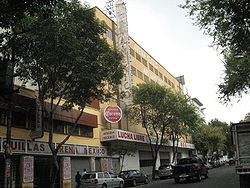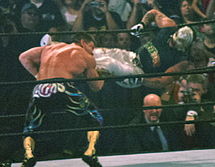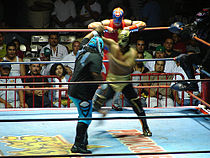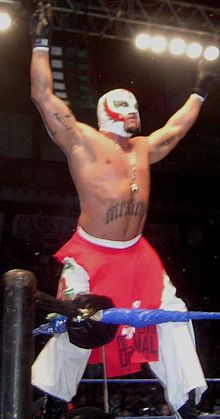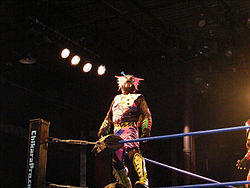- Lucha libre
-
For the comic book series, see Lucha Libre (comics)."Lucha" redirects here. For the publication, see Communist Party of Labour.
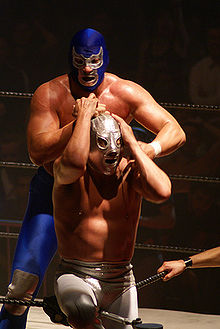 Blue Demon Jr. vs. El Hijo Del Santo.
Blue Demon Jr. vs. El Hijo Del Santo.
Lucha libre (Spanish: Free wrestling) is a term used in Mexico, and other Spanish-speaking countries, for a form of professional wrestling that has developed within those countries. Although the term nowadays refers exclusively to professional wrestling, it was originally used in the same style as the English term "freestyle wrestling", referring to an amateur wrestling style without the restrictions of Greco-Roman wrestling.
Mexican wrestling is characterized by colorful masks, rapid sequences of holds and maneuvers, as well as "high-flying" maneuvers, some of which have been adopted in the United States. The wearing of masks has developed special significance, and matches are sometimes contested in which the loser must permanently remove his mask, which is a wager with a high degree of weight attached. Tag team wrestling is especially prevalent in lucha libre, particularly matches with three-member teams, called trios.
Lucha libre has also transcended the language barrier to some extent as evidenced by works such as Los Luchadores, ¡Mucha Lucha!, and Nacho Libre. Lucha libre wrestlers are known as luchadores (singular luchador) ("fighter(s)").
Rules
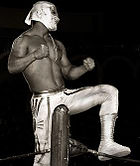 Luchador Místico
Luchador Místico
The rules of lucha libre are similar to American singles matches. Matches can be won by pinning the opponent to the mat for the count of three, making him submit, knocking him out of the ring for a predetermined count (generally twenty) or by disqualification. Using the ropes for leverage is illegal, and once a luchador is on the ropes, his opponent must release any holds and he will not be able to pin him.
Disqualifications occur when an opponent uses an illegal hold, move (such as the piledriver, which is an illegal move in lucha libre and grounds for immediate disqualification, though some variations are legal in certain promotions), or weapon, hits his opponent in the groin (faul), uses outside interference, attacks the referee, or rips his opponent's mask completely off. Most matches are two out of three falls (dos de tres caídas), which had been abandoned for title bouts in North America and Japan in the 1970s.
A rule unique to lucha libre applies during tag team matches, which is when the legal wrestler of a team touches the floor outside the ring, a teammate may enter the ring to take his place as the legal competitor. As the legal wrestler can step to the floor willingly, there is essentially no need for an actual tag to a teammate to bring him into a match. This often allows for much more frenetic action to take place in the ring than would otherwise be possible under standard tag rules.
History of lucha libre in Mexico
 Publicity still of Salvador Lutteroth Gonzáles.
Publicity still of Salvador Lutteroth Gonzáles. Arena Mexico on Dr. Lavista Street in Colonia Doctores in Mexico City
Arena Mexico on Dr. Lavista Street in Colonia Doctores in Mexico City
In the early 1900s, professional wrestling was mostly a regional phenomenon in Mexico until Salvador Lutteroth founded the Empresa Mexicana de Lucha Libre (Mexican Wrestling Enterprise) in 1933, giving the sport a national foothold for the first time. The promotion company flourished and quickly became the premier spot for wrestlers. As television surfaced as a viable entertainment medium during the 1950s, Lutteroth was then able to broadcast his wrestling across the nation, subsequently yielding a popularity explosion for the sport. Moreover, it was the emergence of television that allowed Lutteroth to promote lucha libre’s first breakout superstar into a national pop-culture phenomenon.[1]
In 1942, lucha libre would be forever changed when a silver-masked wrestler, known simply as El Santo (The Saint), first stepped into the ring. He made his debut in Mexico City by winning an 8-man battle royal. The public became enamored by the mystique and secrecy of Santo's personality, and he quickly became the most popular luchador in Mexico. His wrestling career spanned nearly five decades, during which he became a folk hero and a symbol of justice for the common man through his appearances in comic books and movies, while the sport received an unparalleled degree of mainstream attention.[2]
Other legendary luchadores who helped popularize the sport include Gory Guerrero, who is credited with developing moves and holds which are now commonplace in professional wrestling; Blue Demon, a contemporary of Santo and possibly his greatest rival; and Mil Máscaras (Man of A Thousand Masks) who is credited with introducing the high flying moves of lucha libre to audiences around the world. He achieved international fame as one of the first high-flyers, something he was not considered in Mexico, where he fell under the mat-power category.[3][4][5]
Lucha libre style of wrestling
Luchadores are traditionally more agile and perform more aerial maneuvers than professional wrestlers in the U.S. who more often rely on power and hard strikes to subdue their opponents. The difference in styles is due to the independent evolution of the sport in Mexico beginning in the 1930s and the fact that luchadores in the cruiserweight division (peso semicompleto) are often the most popular wrestlers in Mexican lucha libre.[6] Luchadores execute characteristic high flying attacks by using the wrestling ring's ropes to catapult themselves towards their opponents, using intricate combinations in rapid-fire succession, and applying complex submission holds.
Lucha libre has several different weight classes, many catered to smaller agile fighters, who often make their debuts in their mid-teens. This system enables dynamic high-flying luchadores such as Rey Mysterio, Jr., Juventud Guerrera, Super Crazy and Místico, to develop years of experience by their mid-twenties.[7] A number of prominent Japanese wrestlers also started their careers training in Mexican lucha libre before becoming stars in Japan. These include Gran Hamada, Satoru Sayama, Jushin Liger, and Último Dragón. With so many weight classes, Mexico has the largest number of professional wrestlers in the world.
Lucha libre is also known for its tag team wrestling matches. The teams are often made up of three members, instead of two as is common in the U.S. These three man teams participate in what are called trios matches, for tag team championship belts. Of these three members, one member is designated the captain. A successful fall in a trios match can be achieved by either pinning the captain of the opposing team or by pinning both of the other members. A referee can also stop the match because of "excessive punishment". He can then award the match to the aggressors. Falls often occur simultaneously, which adds to the extremely stylized nature of the action. In addition, a wrestler can opt to roll out of the ring in lieu of tagging a partner or simply be knocked out of the ring, at which point one of his partners may enter. As a result, the tag team formula and pacing which has developed in U.S. tag matches is different from lucha libre because the race to tag is not a priority. There are also two-man tag matches (parejas), as well as "four on four" matches (atomicos).[8]
Masks
 The mask of Blue Demon
The mask of Blue Demon
Masks (máscaras) have been used dating back to the beginnings of lucha libre in the early part of the 20th century, and have a historical significance to Mexico in general, dating to the days of the Aztecs.[9] Early masks were very simple with basic colors to distinguish the wrestler. In modern lucha libre, masks are colorfully designed to evoke the images of animals, gods, ancient heroes, and other archetypes, whose identity the luchador takes on during a performance. Virtually all wrestlers in Mexico will start their careers wearing masks, but over the span of their careers, a large number of them will be unmasked. Sometimes, a wrestler slated for retirement will be unmasked in his final bout or at the beginning of a final tour, signifying loss of identity as that character. Sometimes, losing the mask signifies the end of a gimmick with the wrestler moving on to a new gimmick and mask. The mask is considered "sacred" to a degree, so much so that fully removing an opponent's mask during a match is grounds for disqualification.[10]
During their careers, masked luchadores will often be seen in public wearing their masks and keeping up the culture of Lucha Libre, while other masked wrestlers will interact with the public and press normally. However, they will still go to great lengths to conceal their true identities; in effect, the mask is synonymous with the luchador. El Santo continued wearing his mask after retirement, revealed his face briefly only in old age, and was buried wearing his silver mask.
More recently, the masks luchadores wear have become iconic symbols of Mexican culture. Contemporary artists like Francisco Delgado and Xavier Garza incorporate wrestler masks in their paintings.[11]
Although masks are a feature of lucha libre, it is a misconception that every Mexican wrestler uses one. There have been several maskless wrestlers who have been successful, particularly Tarzán López, Gory Guerrero, Perro Aguayo and Negro Casas. Formerly masked wrestlers who lost their masks, such as Satánico, Cien Caras, Cibernético and others, have had continued success despite the mask losses.
Luchas de Apuestas
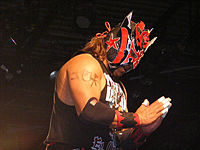 El Oriental's elaborate mask was lost in a lucha de apuesta.
El Oriental's elaborate mask was lost in a lucha de apuesta.
With the importance placed on masks in lucha libre, losing the mask to an opponent is seen as the ultimate insult, and can at times seriously hurt the career of the unmasking wrestler. Putting one's mask on the line against a hated opponent is a tradition in lucha libre as a means to settle a heated feud between two or more wrestlers. In these battles, called luchas de apuestas ("matches with wagers"), the wrestlers "wager" either their mask or their hair.[12]
"In a lucha de apuesta (betting match), wrestlers make a public bet on the outcome of the match. The most common forms are the mask-against-mask, hair-against-hair, or mask-against-hair matches. A wrestler who loses his or her mask has to remove the mask after the match. A wrestler who loses their hair is shaved immediately afterward."[13] If the true identity of a person losing his mask is previously unknown, it is customary for that person to reveal his real name, hometown and years as a professional upon unmasking.
The first lucha de apuestas was presented on 14 July 1940 at Arena México. The defending champion Murciélago (Velásquez) was so much lighter than his challenger (Octavio Gaona), he requested a further condition before he would sign the contract: Octavio Gaona would have to put his hair on the line. Octavio Gaona won the match and Murciélago unmasked, giving birth to a tradition in lucha libre.[14]
Variants
- Máscara contra máscara ("mask versus mask"): two masked luchadores bet their masks, the loser is unmasked by the winner.
- Máscara contra cabellera ("mask versus hair"): a masked wrestler and an unmasked one compete, often after the unmasked one has lost his mask to the masked one in a prior bout. If the masked luchador wins, the unmasked one shaves his head as a sign of humiliation. If the unmasked luchador is the winner, he keeps his hair and the loser is unmasked.
- Cabellera contra cabellera ("hair versus hair"): the loser of the match has his head shaved bald. This can occur both between unmasked wrestlers and between masked wrestlers who have to remove their mask enough to be shaved after the match.
- Máscara o cabellera contra campeonato ("mask or hair versus title"): if the masked or haired luchador loses, the champion unmasks him. But if the champion loses, the luchador is crowned the new champion. An example of this occurred in the WWE, where Rey Mysterio the masked luchador beat the Intercontinental Champion Chris Jericho at WWE The Bash.
- Máscara o cabellera contra retiro ("mask or hair versus career"): if the masked or haired luchador loses, his opponent must resume his career. But if he wins, his opponent must retire
- Carrera contra carrera ("career versus career"): Loser must retire.
Weight classes
Since Lucha Libre has its roots more in Latin American professional wrestling than North American professional wrestling it retains some of the basics of the Latin American version such as more weight classes than professional wrestling in North America. Lucha Libre has a detailed weight class system patterned after boxing. Each weight class has an official upper limit, but examples of wrestlers who are technically too heavy to hold their title can be found. The following weight classes exist in Lucha Libre, as defined by the "Comisión de Box y Lucha Libre Mexico D.F." (the Mexico City Boxing and Wrestling Commission), the main regulatory body in Mexico:[15]
Name (English) Name (Spanish) Weight Limit Titles in division Flyweight Mosca 52 kg (110 lb) None Bantamweight Gallo 57 kg (130 lb) None Featherweight Pluma 63 kg (140 lb) Mexican National, UWA Lightweight Ligero 70 kg (150 lb) Mexican National, UWA, WWA, IWRG Super Lightweight Super Ligero 73 kg (160 lb) CMLL Welterweight Welter 77 kg (170 lb) Mexican National, NWA, CMLL, UWA, WWA, IWRG Super Welterweight Super welter 82 kg (180 lb) IWRG Middleweight Medio 87 kg (190 lb) Mexican National, NWA, CMLL, UWA, WWA, IWRG Super Middleweight / Junior Light Heavyweight Super medio / Semicompleto Junior 92 kg (200 lb) UWA, WWA Light Heavyweight Semi completo 97 kg (210 lb) Mexican National, NWA, CMLL, UWA, WWA Junior Heavyweight / Cruiserweight Completo junior / Crucero 105 kg (230 lb) UWA, AAA Heavyweight Completo 105 kg (230 lb) (Minimum) Mexican National, CMLL, UWA, WWA, IWRG, AAA Other characteristics
Luchador Rey Mysterio
Luchadores are traditionally divided into two categories, rudos (lit. "tough guys", who are "bad guys", or "heels", literally "rude ones"), who bend or break the rules, and técnicos (the "good guys", or "faces", literally "technicians"), who play by the rules and their moves are much more complex and spectacular. Técnicos tend to have very formal combat styles, close to Greco-Roman wrestling and martial arts techniques, whereas rudos tend to be brawlers. Técnicos playing the "good guy" role, and rudos playing the "bad guy" role is very characteristic of Mexican lucha libre, which differs from U.S. professional wrestling, where many technical wrestlers play the role of heels, and many brawlers play as "faces" (e.g., Stone Cold Steve Austin).[16] Although rudos often resort to using underhanded tactics, they are still expected to live up to a luchador code of honor. For instance, a luchador who has lost a wager match would prefer to endure the humiliation of being unmasked or having his head shaved rather than live with the shame that would come from not honoring his bet. Rudos have also been known to make the transition into técnicos after a career defining moment, as was the case with Blue Demon, who decided to become a técnico after his wrestling partner, Black Shadow, was unmasked by the legendary Santo. Tag teams are sometimes composed of both rudos and técnicos in what are called parejas increibles (incredible pairings). Parejas increibles highlight the conflict between a luchador's desire to win and his contempt for his partner.[17]
Luchadores, like their foreign counterparts, seek to obtain a campeonato (championship) through winning key wrestling matches. Since many feuds and shows are built around luchas de apuestas (matches with wagers), title matches play a less prominent role in Mexico than in the U.S. Titles can be defended as few as one time per year and wrestlers usually only wear their belts during big events and title defenses.
Lucha libre uses a more specific weight class system to classify titles. Popular weight classes include: heavyweight, light-heavyweight, welterweight and middleweight. Lightweight and super-lightweight titles are also used. The Cruiserweight division is often associated with the lucha libre style of wrestling, even though in Mexico, the term light-heavyweight (peso semicompleto) is used due to a different weight class system. In recent years, weight classes have been mostly nominal and there are occasions when a wrestler will have titles in two different weight classes. However, title matches are still major events and many shows are built around them.
The two most popular lucha libre promotions are Consejo Mundial de Lucha Libre (CMLL), which was founded in 1933, and Asistencia Asesoría y Administración (AAA).
Lucha libre is currently experiencing a boom in popularity due to the emergence of a new generation of stars, most notably, a masked wrestler named Místico now known as Sin Cara, whose high-flying style and technique attracted record crowds in Mexico before he signed with WWE.
Female professional wrestlers
Female wrestlers or luchadoras also compete in Mexican lucha libre. The CMLL World Women's Championship is the top title for CMLL's women's division; while the AAA Reina de Reinas Championship is a championship defended in an annual tournament by female wrestlers in AAA. AAA also recognizes a World Mixed Tag Team Championship, contested by tag teams composed of a luchador and luchadora respectively. In 2000, the all female promotion company Lucha Libre Femenil (LLF) was founded.[18]
Mini-Estrellas
Main article: Mini-EstrellaLucha Libre has a division called the "Mini-Estrella" or "Minis" division, which unlike North American midget professional wrestling is not just for dwarves but also for luchadores that are short, originally the limit for the Mini division was 5 feet but in recent years wrestlers such as Pequeño Olímpico have worked the Minis division despite being 1.69 m (5 ft 6 1⁄2 in) tall.[19] The Minis division was first popularized in the 1970s with wrestlers like Pequeño Luke and Arturito (a wrestler with an R2-D2 gimmick) becoming noticed for their high flying abilities. In the late 1980s/early 1990s CMLL created the first actual "Minis" division, the brainchild of then-CMLL booker Antonio Peña. CMLL created the CMLL World Mini-Estrella Championship in 1992, making it the oldest Minis championship still in existence today.[20] Minis are often patterned after "regular sized" wrestlers and are sometimes called "mascotas" ("pets") if they team with the regular sized version.[19]
Luchadores in the U.S.
In 1994, AAA promoted the When Worlds Collide pay-per-view in conjunction with the U.S. promotion company World Championship Wrestling (WCW). When Worlds Collide introduced U.S. audiences to many of the top luchadores in Mexico at the time.
In recent years, several luchadores have found success in the United States. Notable luchadores who achieved success in the U.S. are Eddie Guerrero, Rey Mysterio, Jr., Juventud Guerrera, La Parka, Super Crazy and Psicosis.
Lucha libre shows are broadcast weekly in the U.S. on the Galavisión and LA TV Spanish language cable networks.
Additional information
In Peru the term "cachascán" (from "catch as can") is used. Wrestlers are called cachascanistas. In Argentina, in addition to lucha libre, professional wrestling is also referred to as "catch", or catch as catch can.[21] In Bolivian Lucha Libre, wrestling Cholitas — female wrestlers dressed up as indigenous Aymara — are popular.[22][23]
Promotions using lucha libre rules
Mexico
- Consejo Mundial de Lucha Libre (CMLL)
- Asistencia Asesoría y Administración (AAA)
- International Wrestling Revolution Group (IWRG)
- Universal Wrestling Association (defunct)
- World Wrestling Association (Promociones Mora)
- Universal Wrestling Entertainment (UWE)
- Alianza Universal de Lucha Libre (AULL)
- Xtreme Latin American Wrestling (XLAW)
- PROLLM
- Lucha Libre Feminil (LLF)
- Nueva Generación Extrema (NGX)
- Desastre Total Ultraviolento (DTU)
- Arena Club Deportivo Unidos De Lucha Libre (DULL)
- Arena Club Deportivo Anahuac De Lucha Libre
- Arena Club Deportivo Amigo Jr De Lucha Libre (DALL)
- Arena Club Deportivo Bombero De Lucha Libre
- Arena De Lucha Libre Tigre Espanol
- Arena Club Deportivo Las Torres De Lucha Libre
- Arena De Lucha Libre Ben-Hur (Red Line Promotions)
Japan
- Michinoku Pro Wrestling
- Osaka Pro Wrestling
- Pro Wrestling KAGEKI
- Toryumon / Dragon Gate
- Universal Lucha Libre (defunct)
United States
- Chikara
- Incredibly Strange Wrestling
- Lucha Libre USA
- Delgado Promotions
- Ocean Pools Promotions
- Felix Promotions
- GALLI Lucha Libre Chicago
Puerto Rico
- World Wrestling Council (WWC)
- International Wrestling Association (IWA)
- Capitol Sports Promotions (became WWC)
Lucha libre in popular culture
Lucha libre has crossed over into popular culture, especially in Mexico where it is the second most popular sport after Football (soccer).[24] Outside of Mexico Lucha Libre has also crossed over into popular culture, especially in movies and television.
Movies and television
See also: Lucha filmThe motion picture Nacho Libre, starring Jack Black as a priest-turned-luchador was inspired by the story of real life Priest turned Luchador Father Sergio Gutiérrez Benítez who wrestled as Fray Tormenta to make money for his church. The American horror movie Wrestlemaniac is centered around the story of an insane luchador with abnormal strength; the titular villain is played by luchador Rey Misterio, Sr. Rob Zombie's animated film The Haunted World of El Superbeasto stars a Mexican luchador named El Superbeasto. The candid, heart-wrenching tale of Carmen Rosa, a Bolivian luchadora, is told in Betty M. Park's 2009 documentary 'Mamachas del Ring'.
Television has also seen shows inspired by Lucha Libre, especially animated series such as ¡Mucha Lucha!, Cartoon Network also produced an animated mini-series based on luchador El Santo.[25] The world of Lucha Libre has also been used as inspirations for episodes of television series, most notably the 200th episode of CSI, "Mascara" centered on the investigation of visiting luchadores with connections to a murder. The WB television series Angel episode entitled "The Cautionary Tale of Numero Cinco" told the story of a family of luchadores called "Los Hermanos Números" who also fought evil. Angel must help the remaining brother, Numero Cinco, defeat the Aztec warrior-demon that killed his four brothers. Lucha Libre has also inspired television shows outside of the United States; In the British TV show Justin Lee Collins: The Wrestler, Colins competes as the rudo El Glorioso, or The Glorious One, against the exotico Cassandro in The Roundhouse, London, ultimately losing and being de-masked.[26]
Games and print media
Many fighting video games have featured characters based on luchadores, featuring both the masked aspects and the different wrestling style of Lucha Libre compared to traditional professional wrestling. In Tekken the characters King and Armor King both wear the "Jaguar Mask", while the latest trailer for Tekken Tag Tournament 2 showed a female luchador, with similarities to Rey Mysterio. In other fighting games characters are luchadores fighting in the tournaments for a living such as: El Fuerte from Street Fighter IV, Ramon, Tizoc, and Raiden from The King of Fighters, Lisa from Dead or Alive and El Blaze from Virtua Fighter. A Japanese wrestler, Takuya Sugi has actually wrestled as "El Blazer" in Japan.
The 2D wrestling arcade game "Saturday Night Slam Masters" released by Japanese game company Capcom in 1993 featured a final boss character called "El Escorpión" (The Scorpion), whose appearance was inspired by a legendary Mexican "Luchador" called Tinieblas. The character's name in the original Japanese edition of the game was "The Astro" (アストロ, Asutoro). One of the regular characters, El Stingray, is also a luchador.
In the Music/Rhythm Game DJ Hero, a playable character named "Jugglernort" is a buff ex-Luchador Disc Jockey originating from Mexico. The game description explains that he got thrown in prison for "throwing beats" and he learned from then on how to "spin beats". It also states that he still has a strong suplex he can perform on anyone who crosses his path.
In other games Luchadors are not part of the game but the cultural inspiration is still seen, for instance in the video game No More Heroes for the Nintendo Wii, the main character, Travis Touchdown occasionally finds luchador masks through-out the game, which re-teach him wrestling moves that you can use from then on. The game also features trading cards that feature the masks of past, legendary luchadores. Suda 51, game developer and head of Grasshopper Studios is known for his fascination of Lucha Libre and often includes them in his game, such as the character MASK de Smith in killer7 and was responsible for the collectible Lucha Libre masks in No More Heroes.
In April 2010, Konami announced Lucha Libre AAA: Héroes del Ring, which is the first major wrestling video game solely focused on Lucha Libre.
While Luchador comics are a well known phenomenon in Mexico, featuring wrestlers from El Santo to Cibernético, comics outside of Mexico also draw on the images and culture of Lucha Libre. The comic Sonambulo revolves around a crime fighting luchador who possesses supernatural powers. In the rock and roll comic series The_Amazing_Joy_Buzzards El Campeon is a luchador genie who is summoned by using a magic amulet by those in need. Doctor Eggman, the main antagonist in the Sonic the Hedgehog series, wrestles as "El Gran Gordo" (Spanish for, roughly, "The Big Fat One") in the Sonic X comicseries.[27] The martial arts manga Tenjho Tenge includes a character named Kōji Sagara who fights in the lucha libre style. The anime Air Master features a luchador style character called Lucha Master.
Lucha libre inspirations
Nike has designed a line of lucha libre inspired athletic shoes.[28] Coca-Cola developed a Blue Demon Full Throttle energy drink named after the luchador Blue Demon, Jr. who is also the spokesperson for the drink in Mexico.[29] Coca-Cola also introduced "Gladiator" in Mexico, an energy drink that sponsored CMLL events and who featured CMLL wrestlers such as Místico and Último Guerrero.[30]
The Nashville-based Anglo band Los Straitjackets adopted personalized luchador masks as part of their stage show in the mid-1990s, and have since acquired a large Mexican following.
See also
- Luchador film
- Luta livre
Notes
- Paul Allatson (2007). Key Terms in Latino/a Cultural And Literary Studies [1]. Blackwell Publishing. ISBN 1-4051-0250-0.
References
- ^ The History of Lucha Libre
- ^ Professional Wrestling Online Museum - Ring Chronicle Hall of Fame Inductee - El Santo
- ^ Lucha Legends: Gory Guerrero
- ^ Blue Demon
- ^ Interview: Mil Mascaras and Satoru Sayama
- ^ :: Lucha Libre USA ::
- ^ CANOE - SLAM! Sports - Wrestling - Lucha Libre 101
- ^ 8.6. Lucha Libre confuses me, what are the rules?
- ^ Madigan, Dan (2007). "What is Lucha Libre". Mondo Lucha Libre: the bizare & honorable world of wild Mexican wrestling. HarperColins Publisher. pp. 2–15. ISBN 978-0-06-085583-3.
- ^ Who Was That Masked Man? - Tempo
- ^ X a v i e r G a r z a
- ^ CANOE - SLAM! Sports - Wrestling - Viva la lucha libre!
- ^ Heather Levi (2008). The World of Lucha Libre: Secrets, Revelations, and Mexican National Identity. Duke University Press. p. 30. ISBN 978-0-8223-4232-8. http://www.americanethnography.com/article.php?id=88.
- ^ Lourdes Grobet, Alfonso Morales, Gustavo Fuentes, and Jose Manuel Aurrecoechea (2005). Lucha Libre: Masked Superstars of Mexican Wrestling. Trilce. p. 115. ISBN 978-1-933045-05-4.
- ^ Arturo Montiel Rojas (2001-08-30). "REGLAMENTO DE BOX Y LUCHA LIBRE PROFESIONAL DEL ESTADO DE MEXICO". Comisión de Box y Lucha Libre Mexico D.F.. http://www.ordenjuridico.gob.mx/Estatal/ESTADO%20DE%20MEXICO/Reglamentos/MEXREG004.pdf. Retrieved 2009-04-03. ""CAPITULO XXVI> DEL PESO DE LOS LUCHADORES""[dead link]
- ^ Wrestling Encyclopedia
- ^ Lucha Libre Moves
- ^ Among the new group of notable female luchadoras is El Gato de Plata (believed to be Ella Brown)CANOE - SLAM! Sports - Wrestling - LLF promoter loves his luchadoras
- ^ a b Madigan, Dan (2007). "You ain't seen nothing yet: the minis". Mondo Lucha Libre: the bizare & honorable world of wild Mexican wrestling. HarperColins Publisher. pp. 209—212. ISBN 978-0-06-085583-3.
- ^ Royal Duncan & Gary Will (2000). "Mexico: EMLL CMLL Midget (miniestrella) Title". Wrestling Title Histories. Archeus Communications. p. 396. ISBN 0-9698161-5-4.
- ^ Federacion Argentina De Catch
- ^ Crooker, Patricio. "The Wrestling cholitas of El Alto, Bolivia". American Ethnography Quasimonthly. http://www.americanethnography.com/article.php?id=94. Retrieved 2009-08-16.
- ^ Guillermoprieto, Alma (September 2008). "Bolivia's Wrestlers". National Geographic. http://ngm.nationalgeographic.com/2008/09/wrestlers/guillermoprieto-text. Retrieved 2009-08-16.
- ^ Yoav (October 22, 2007). "ENCUESTA DE MITOFSKY REVELA QUE LA LUCHA NO ES EL SEGUNDO DEPORTE MÁS POPULAR EN MÉXICO" (in Spanish). SuperLuchas Magazine. http://superluchas.net/2007/10/22/encuesta-de-mitofsky-revela-que-la-lucha-no-es-el-segundo-deporte-mas-popular-en-mexico/. Retrieved September 5, 2009.
- ^ Cartoon Network Announces Five New Series for 2007
- ^ Teeman, Tim (14 August 2009). "Dolce Vito; Justin Lee Collins: Wrestler; How Clean Is Your House? - Last Night's TV". Home Arts & Entertainment TV & Radio (London: The Times). http://entertainment.timesonline.co.uk/tol/arts_and_entertainment/tv_and_radio/article6794855.ece. Retrieved 14 August 2009.
- ^ http://eggmanempire.sonicworld.net/article8.php
- ^ Lucha Libre Air Force Ones - NiceKicks.com
- ^ BevNET.com - Coca-Cola Introduces New Full Throttle Blue Demon Energy Drink
- ^ Ocampo, Jorge (January 30, 2008). "Coca Cola México lanza Gladiator" (in Spanish). SuperLuchas Magazine. http://superluchas.net/2008/01/30/coca-cola-mexico-lanza-gladiator/. Retrieved September 5, 2009.
External links
- luchalords
- Lucha Wiki
- Lucha Libre Video
- From Parts Unknown - Pop-culture resource for Mexican wrestling
- Pro-Wrestling Title Histories of Mexico
- SuperLuchas Top Mexican Lucha Libre Magazine (Spanish)
- Super Libre Mexican Lucha Libre On Line Magazine (Spanish)
- [2] (Spanish)
- [3] (Spanish)
- [4]
 Professional wrestling in Mexico
Professional wrestling in MexicoMajor promotions Independent promotions International Wrestling League · International Wrestling Revolution Group · Perros del Mal · World Wrestling Association · Other promotionsDefunct promotions Lucha Libre culture Categories:- Lucha libre
- Sports entertainment
- Professional wrestling genres
Wikimedia Foundation. 2010.

